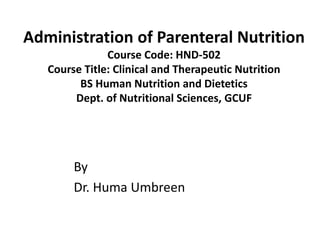
administration of parenteral nutrition.pptx
- 1. Administration of Parenteral Nutrition Course Code: HND-502 Course Title: Clinical and Therapeutic Nutrition BS Human Nutrition and Dietetics Dept. of Nutritional Sciences, GCUF By Dr. Huma Umbreen
- 2. Insertion Care • A skilled nurse can place catheters into peripheral veins • Placement of catheters directly into central veins requires insertion by a qualified physician. • Patients may be awake for the procedure and given local anesthesia.
- 3. Care of catheter • Catheter-related problems frequently cause complications • Catheters are sometimes improperly positioned or may dislodge after placement. • Air may leak into catheters, obstructing blood flow. • Catheters inserted into peripheral veins may cause phlebitis, requiring reinsertion at an alternate site. • A catheter may become clogged from blood clotting • Catheters are also a leading cause of infection: contamination may be introduced during insertion, at the placement site, or from a contaminated solution. • Routine inspections of equipment and frequent monitoring of patients’ symptoms help to minimize the problems associated with catheter use.
- 4. Administration of Parenteral Solution • A common approach is to start solution infusion at a slow rate and gradually increase the infusion rate over a two- to three-day period. – For example, 40 milliliters per hour may be infused during the first 24 hours of administration (supplying 960 milliliters) and the rate increased by one liter per day until the goal rate is reached. • Another approach is to give the full volume of a nutrient-dilute solution on the first day and advance nutrient concentrations as tolerated.
- 5. Cont…. • Blood glucose and electrolyte levels are checked regularly to determine tolerance to solutions. • Frequent reassessment of nutrient intakes may be necessary until a patient has stabilized. • Rapid changes in infusion rate are discouraged in some patients (especially newborn infants) due to a risk of developing hyperglycemia or hypoglycemia
- 6. Cont…. • Parenteral solutions may be infused continuously over 24 hours (continuous parenteral nutrition) or during 10- to 16-hour periods only (cyclic parenteral nutrition). • Continuous feedings are often given to critically ill and malnourished patients who cannot receive adequate nutrition during shorter time periods. • Cyclic feedings are often provided at night so that patients can participate in routine activities during the day.
- 7. Metabolic Complications • Hyperglycemia,■ a common consequence of intravenous feedings, most often occurs in patients who are glucose intolerant or are undergoing severe metabolic stress. • It may be prevented – by providing insulin along with feedings – Or by restricting the amount of dextrose in a solution. • Dextrose infusions are often limited to less than 5 milligrams per kilogram of body weight per minute in critically ill adult patients so that carbohydrate intakes do not exceed the maximum glucose oxidation rate.
- 8. Cont… • Hypoglycemia Although uncommon, hypoglycemia may occur when feedings are interrupted or discontinued. • In patients at risk, such as young infants, feedings may be tapered off over several hours before discontinuation. • Hypertriglyceridemia may occur in critically ill patients who are unable to tolerate the amount of lipid emulsion that is supplied. • It may also result from excessive carbohydrate feedings or from severe infection, which impairs lipid clearance. • These conditions may limit the amount of lipid emulsion that can be safely infused.
- 9. Cont… • Refeeding Syndrome Severely malnourished patients who are fed aggressively (parenterally or otherwise) may exhibit refeeding syndrome, characterized by electrolyte and fluid imbalances and hyperglycemia. • To prevent refeeding syndrome, feedings are started slowly and electrolyte levels monitored carefully when malnourished patients begin receiving nutrition support.
- 10. Cont… • Abnormalities in Liver Function Fatty liver often results from parenteral feedings, and therefore serum levels of liver enzymes are routinely monitored. • Usually, liver complications are readily reversed when parenteral feedings are discontinued.